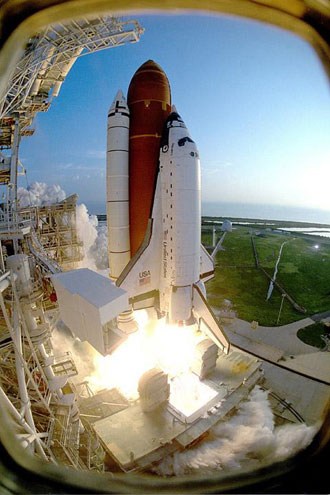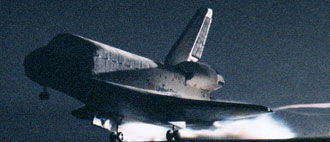- NASA Home
- | Centers
- | Kennedy Space Center
- | Shuttle Operations
- | Orbiters
NASA Orbiter Fleet
Space Shuttle Overview: Discovery (OV-103)
After checkout and processing, it was launched on Aug. 30, 1984, for its first mission, 41-D, to deploy three communications satellites.
 Since that inaugural flight, Discovery has completed more than 30 successful missions, surpassing the number of flights made by any other orbiter in NASA's fleet. Just like all of the orbiters, it has undergone some major modifications over the years. The most recent began in 2002 and was the first carried out at Kennedy. It provided 99 upgrades and 88 special tests, including new changes to make it safer for flight.
Since that inaugural flight, Discovery has completed more than 30 successful missions, surpassing the number of flights made by any other orbiter in NASA's fleet. Just like all of the orbiters, it has undergone some major modifications over the years. The most recent began in 2002 and was the first carried out at Kennedy. It provided 99 upgrades and 88 special tests, including new changes to make it safer for flight. Image left: Space Shuttle Discovery lifts off Pad B at the Kennedy Space Center on September 12, 1993, to begin STS-51. Image credit: NASA
Discovery has the distinction of being chosen as the Return to Flight orbiter twice. The first was for STS-26 in 1988, and the second when it carried the STS-114 crew on NASA's Return to Flight mission to the International Space Station in July 2005.
The choice of the name "Discovery" carried on a tradition drawn from some historic, Earth-bound exploring ships of the past. One of these sailing forerunners was the vessel used in the early 1600s by Henry Hudson to explore Hudson Bay and search for a northwest passage from the Atlantic to the Pacific.
Another such ship was used by British explorer James Cook in the 1770s during his voyages in the South Pacific, leading to the discovery of the Hawaiian Islands. In addition, two British Royal Geographical Society ships have carried the name "Discovery" as they sailed on expeditions to the North Pole and the Antarctic.
Destined for exploring the heavens instead of the seas, it was only fitting that NASA's Discovery carried the Hubble Space Telescope into space during mission STS-31 in April 1990, and provided both the second and third Hubble servicing missions (STS-82 in February 1997 and STS-103 in December 1999).
 Image right: On February 21, 1997, the Space Shuttle Discovery touches down in darkness on Runway 15 of the KSC Shuttle Landing Facility, bringing to a close the 10-day STS-82 mission to service the Hubble Space Telescope (HST). Image credit: NASA
Image right: On February 21, 1997, the Space Shuttle Discovery touches down in darkness on Runway 15 of the KSC Shuttle Landing Facility, bringing to a close the 10-day STS-82 mission to service the Hubble Space Telescope (HST). Image credit: NASA During its many successful trips to space, Discovery has carried satellites aloft, ferried modules and crew to the International Space Station, and provided the setting for countless scientific experiments.
Construction Milestones
| January 29, 1979 | Contract Award |
| August 27, 1979 | Start long lead fabrication of Crew Module |
| June 20, 1980 | Start fabrication lower fuselage |
| November 10, 1980 | Start structural assembly of aft-fuselage |
| December 8, 1980 | Start initial system installation aft fuselage |
| March 2, 1981 | Start fabrication/assembly of payload bay doors |
| October 26, 1981 | Start initial system installation, crew module, Downey |
| January 4, 1982 | Start initial system installation upper forward fuselage |
| March 16, 1982 | Midfuselage on dock, Palmdale |
| March 30, 1982 | Elevons on dock, Palmdale |
| April 30, 1982 | Wings arrive at Palmdale from Grumman |
| April 30, 1982 | Lower forward fuselage on dock, Palmdale |
| July 16, 1982 | Upper forward fuselage on dock, Palmdale |
| August 5, 1982 | Vertical stabilizer on dock, Palmdale |
| September 3, 1982 | Start of Final Assembly |
| October 15, 1982 | Body flap on dock, Palmdale |
| January 11, 1983 | Aft fuselage on dock, Palmdale |
| February 25, 1983 | Complete final assembly and closeout installation, Palmdale |
| February 28, 1983 | Start initial subsystems test, power-on, Palmdale |
| May 13, 1983 | Complete initial subsystems testing |
| July 26, 1983 | Complete subsystems testing |
| August 12, 1983 | Completed Final Acceptance |
| October 16, 1983 | Rollout from Palmdale |
| November 5, 1983 | Overland transport from Palmdale to Edwards |
| November 9, 1983 | Delivery to Kennedy Space Center |
| June 2, 1984 | Flight Readiness Firing |
| August 30, 1984 | First Flight (41-D) |
Upgrades and Features
Discovery benefited from lessons learned in the construction and testing of Enterprise, Columbia and Challenger. At rollout, its weight was some 6,870 pounds less than Columbia.
Beginning in the fall of 1995, the orbiter underwent a nine-month Orbiter Maintenance Down Period (OMDP) in Palmdale California. The vehicle was outfitted with a 5th set of cryogenic tanks and an external airlock to support missions to the International Space Station. It returned to the Kennedy Space Center, riding piggy-back on a modified Boeing 747, in June 1996.
Following STS-105, Discovery became the first of the orbiter fleet to undergo Orbiter Major Modification (OMM) period at the Kennedy Space Center. Work began in September 2002, and along with the scheduled upgrades, additional safety modifications were added as part of the preparations for Return to Flight.
For additional information, visit:
+ Space Shuttle Facts and Statistics